A Square D panel schedule template is a pre-designed document that helps organize and record information about the electrical circuits and devices in a Square D electrical panel.
It typically includes sections to record circuit numbers, circuit descriptions, breaker sizes, wire sizes, and the load connected to each circuit. This template is commonly used by electricians, electrical contractors, engineers, and building inspectors to provide detailed information about the electrical loads and circuits in an electrical panel manufactured by Square D, a brand of Schneider Electric. It allows them to create a clear and organized panel schedule for reference and maintenance purposes. The templates are available in various formats, including digital templates for computer-based programs or pre-printed templates for manual documentation.
Electrical panels and circuits are crucial in the distribution of electricity in a building. Electrical panels receive electricity from the main power source and distribute it to various circuits throughout the building. Circuits are pathways that carry electrical current from the panel to different areas within the building. Each circuit is protected by a fuse or breaker, which acts as a safety device to prevent overloading and other electrical hazards.
This article will address the features of a panel schedule template, its components, and how to fill it out. Some common mistakes when using the template and how to avoid them have also been addressed. Free printable templates have been provided in Word, Excel, and PDF formats for your ease.
Features of Square D Panel Schedule Templates
The templates have several features that streamline the process of creating panel schedules.
These key features include:
- The templates have a user-friendly layout, making it easier to input and organize information. They contain pre-defined headers, sections, and labels, making them highly usable and easy to navigate.
- The templates have adequate space to record vital circuit details, such as circuit numbers, breaker sizes, wire sizes, and load calculations, among others. They provide a centralized location for recording essential information in an organized manner, making it simpler to identify circuits during installation, maintenance, or troubleshooting.
- To minimize errors, the templates contain visual elements such as clear font styles, appropriate font sizes, and proper formatting that improve clarity and readability. They also incorporate graphic elements such as colors, vector elements, and headers to distinguish the different sections of the template. A visually clear template minimizes the likelihood of errors and improves accuracy and efficiency when recording panel and circuit information.
- Some panel schedule templates are available in digital formats, allowing electronic data entry. These can be used with specialized electrical design, spreadsheet, or word processing software. Digital compatibility allows for seamless collaboration and accessibility of the schedule, ensuring everyone involved has a shared understanding of the electrical system.
- To promote workplace safety, the templates can be designed to align with relevant electrical codes and regulations. They can incorporate sections and necessary information required by regulatory authorities, ensuring compliance with industry standards.
Components of a Panel Schedule Template
A template for a panel schedule typically contains the following elements:
Panel Identification
The first section of the template is a field to specify the electrical panel identification or label. This allows you to identify a specific panel in a building or facility with multiple electrical panels. This information allows for easy reference when performing maintenance or troubleshooting the entire electrical system.
Panel location
The next section is to specify the physical location of the electrical panel. You can mention the name of the building, floor, room, or any other relevant identifying information. This information is especially useful in large buildings with an extensive electrical system.
Panel network address
If the electrical panel is connected to a network, you may specify the unique address assigned to it in this field of the template. This information is useful, especially when the panel is part of an automated or controlled system. It also allows you to integrate the panel effortlessly with other systems for communication or remote monitoring purposes.
Circuit number
This is a column for specifying the unique identification number assigned to each circuit to identify it within the electrical panel quickly. This information helps you reference circuits accurately to manage the electrical system more efficiently.
Description
In this column of the template, you can provide a clear description of each circuit to understand its essence. You can specify its location and purpose, so electricians or building inspectors going through the form can identify its function.
Quadrant and zone number
This is a column for specifying the quadrant or zone associated with each circuit. By categorizing circuits into quadrants, you can easily organize and identify circuits that are part of a more extensive electrical system, allowing for easier identification, troubleshooting, maintenance, and modification.
Load calculation
In this template column, you can input the electrical load of each circuit in amperes (A). By specifying the amperage of each circuit, you can determine its maximum capacity and compatibility. To ensure each circuit does not experience an electricity overload, these calculations should be accurate so the entire system functions safely.
Breaker size
This column is for inputting the appropriate breaker size for each circuit. Electrical codes and regulations usually require this information to be provided to protect circuits from short circuits and overloads. Since the breaker size should match each circuit’s load requirement, including this information contributes to the reliability and safety of the electrical system.
Wire size
The final column of the template is for recording the proper wire gauge for each circuit. When determining the suitable wire size, amperage, load size, electrical code requirements, and voltage drop are often considered. This information ensures the circuit can safely transmit electricity without significant voltage drop or resistance. Appropriate wire sizing ensures the electrical system remains efficient and reliable.
Free Templates
For your convenience, we have provided a vast collection of free downloadable templates in Excel, Word, and PDF formats. They are designed to simplify the process of documenting and organizing electrical circuits and loads within an electrical panel. You can effortlessly input and update the information to ensure accuracy and consistency in your Square D panel schedule. Make the most of these resources to streamline your panel scheduling tasks and enhance your electrical system management.
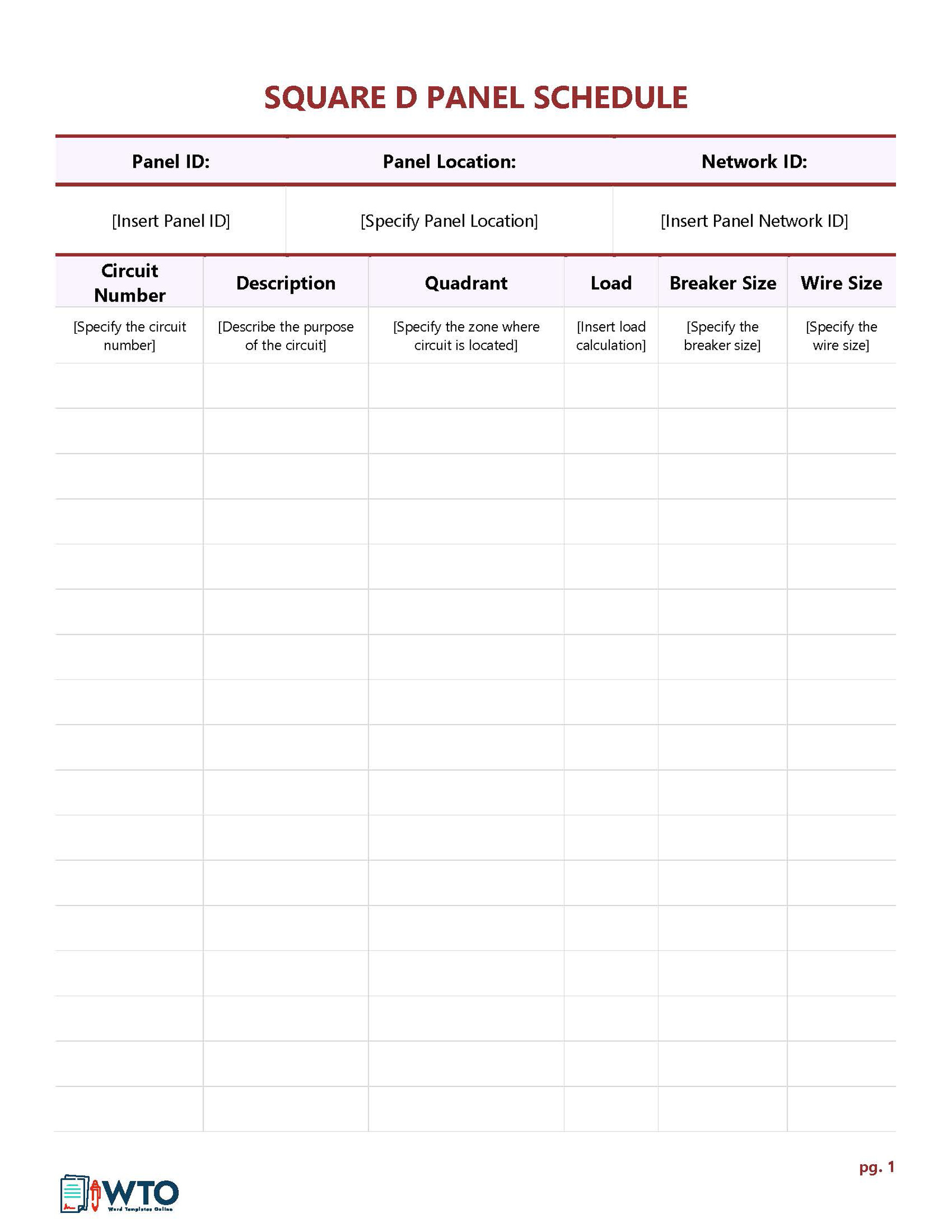
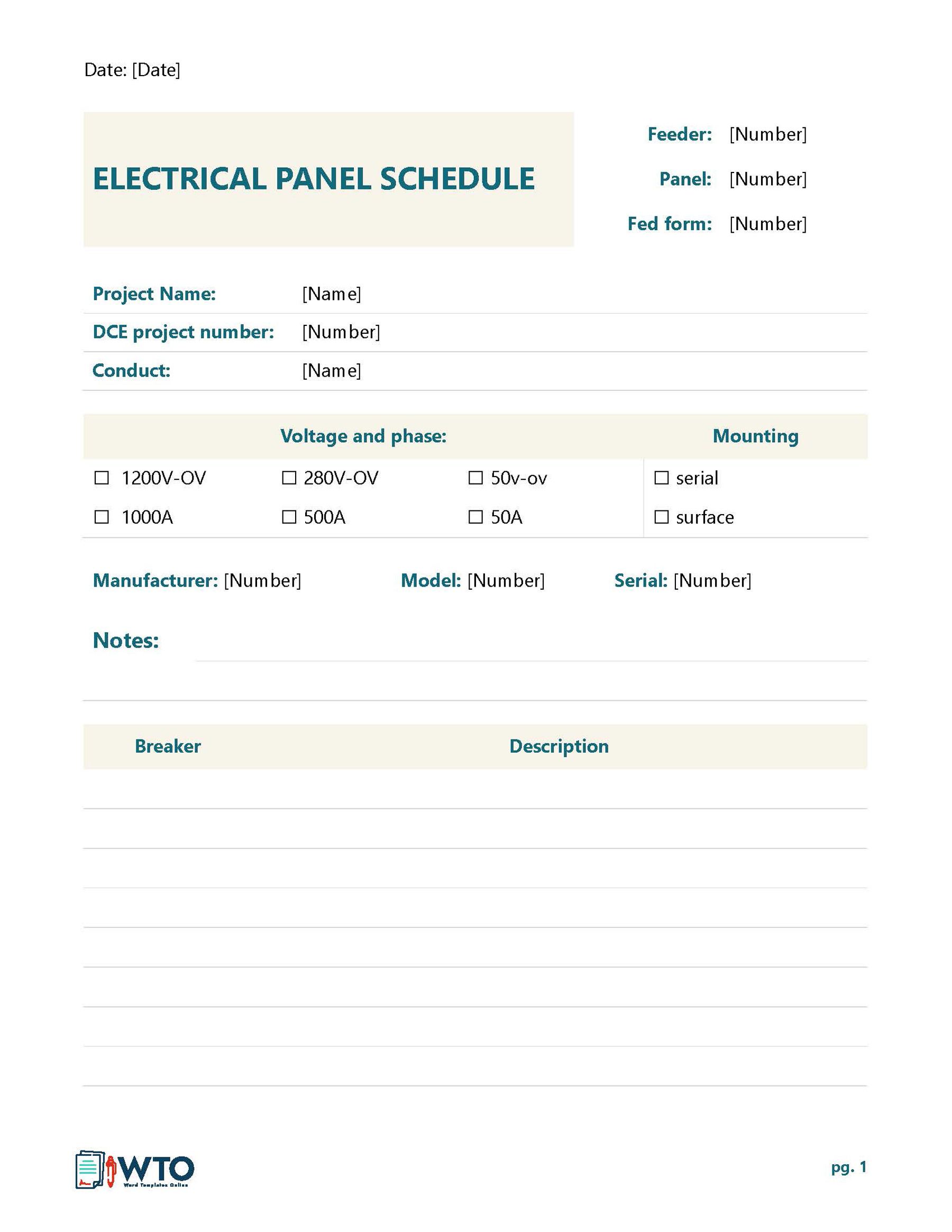
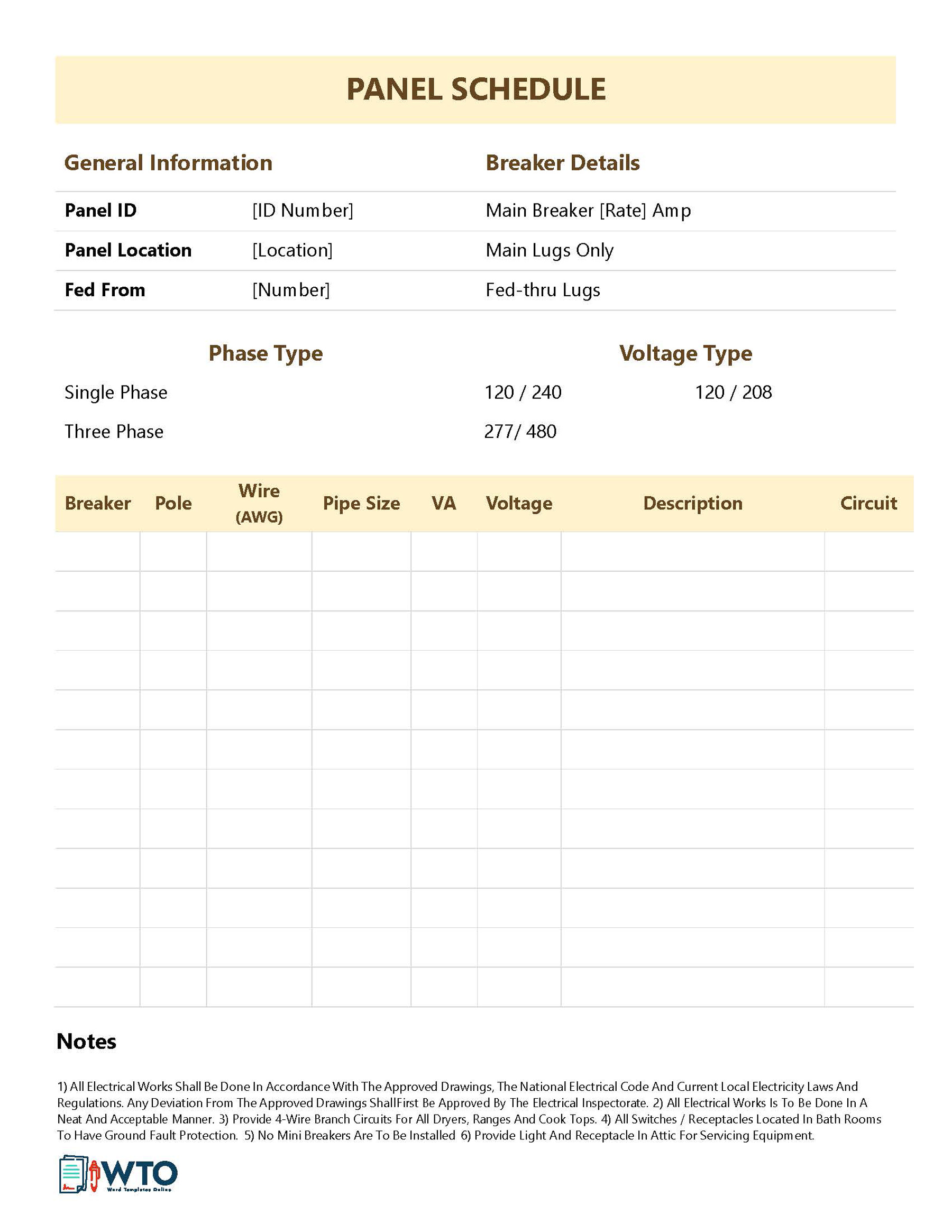
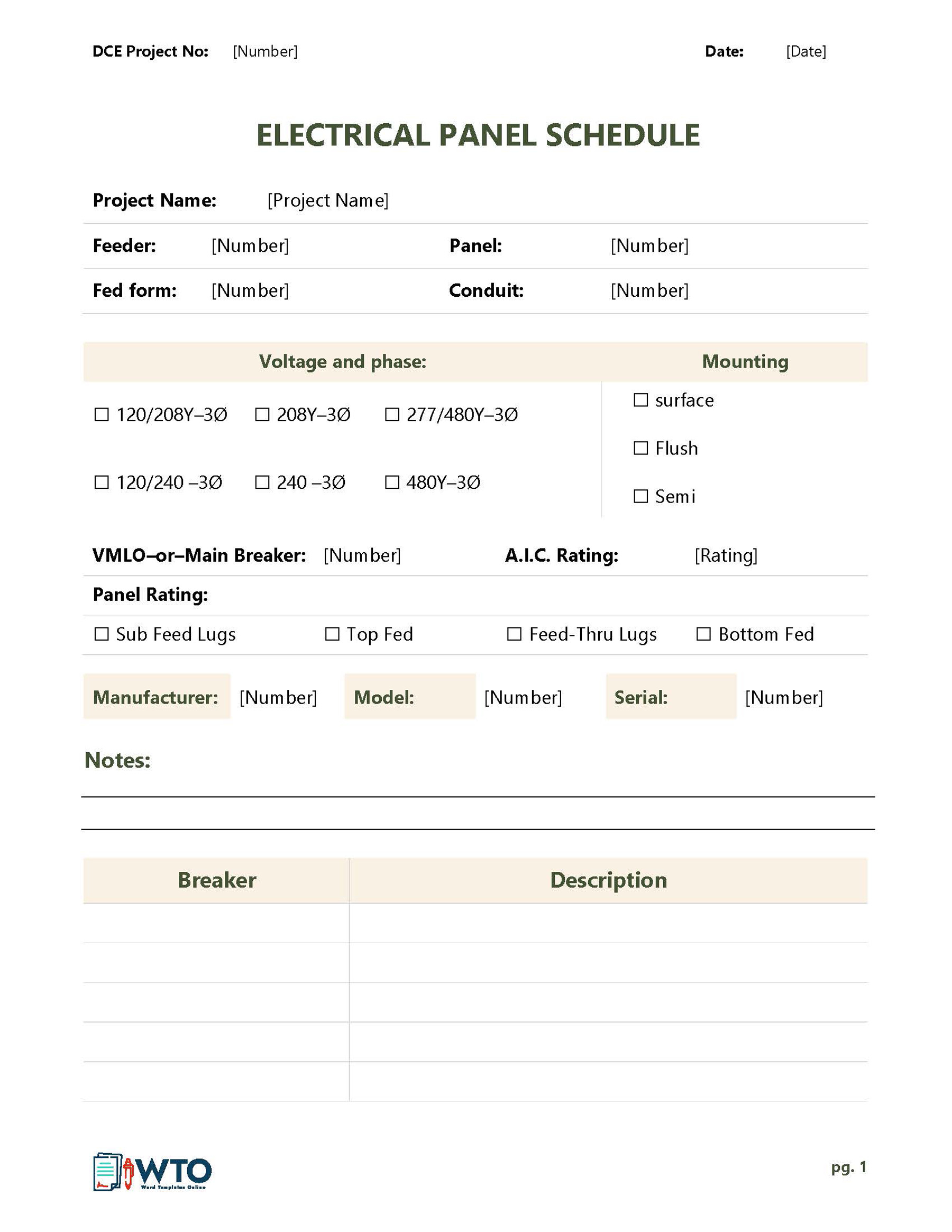
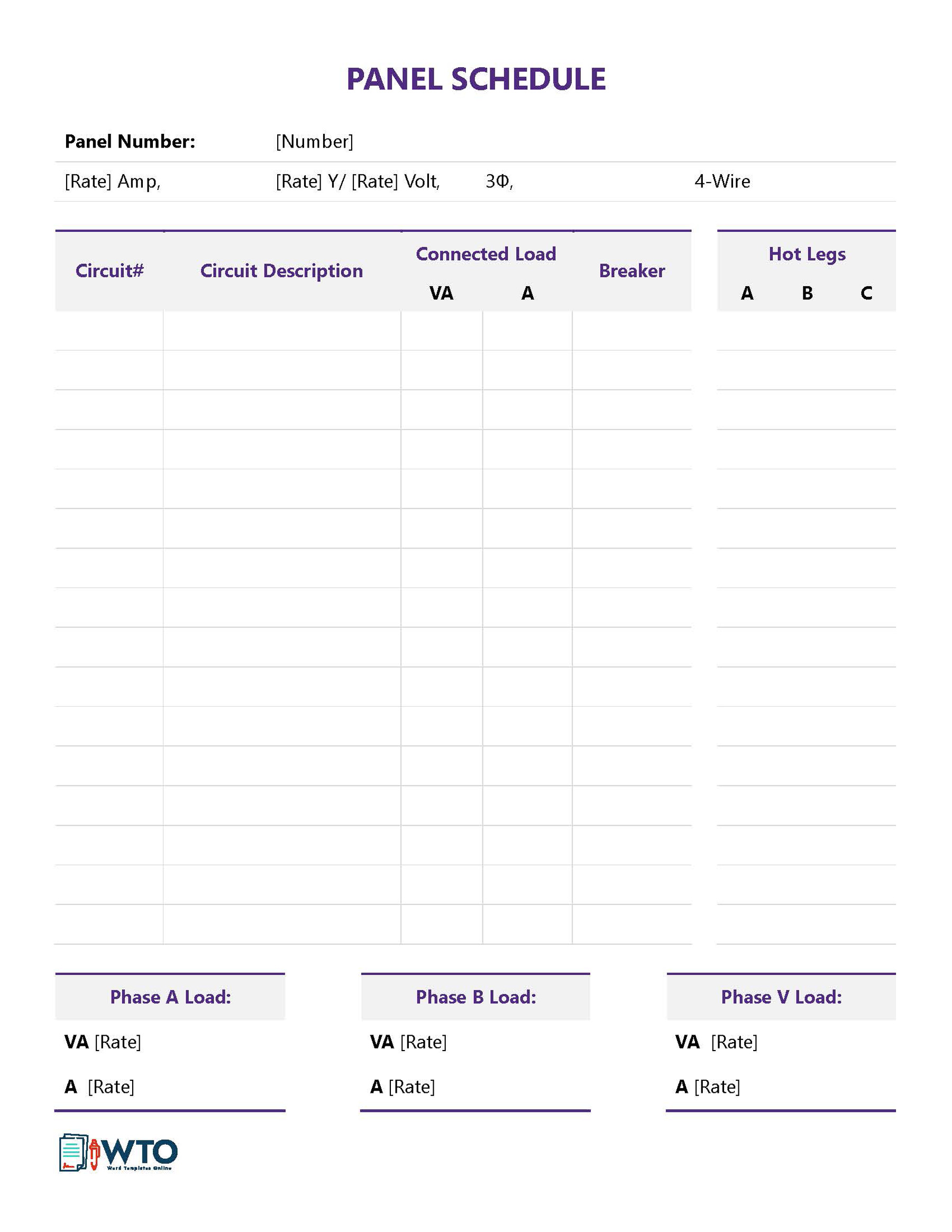
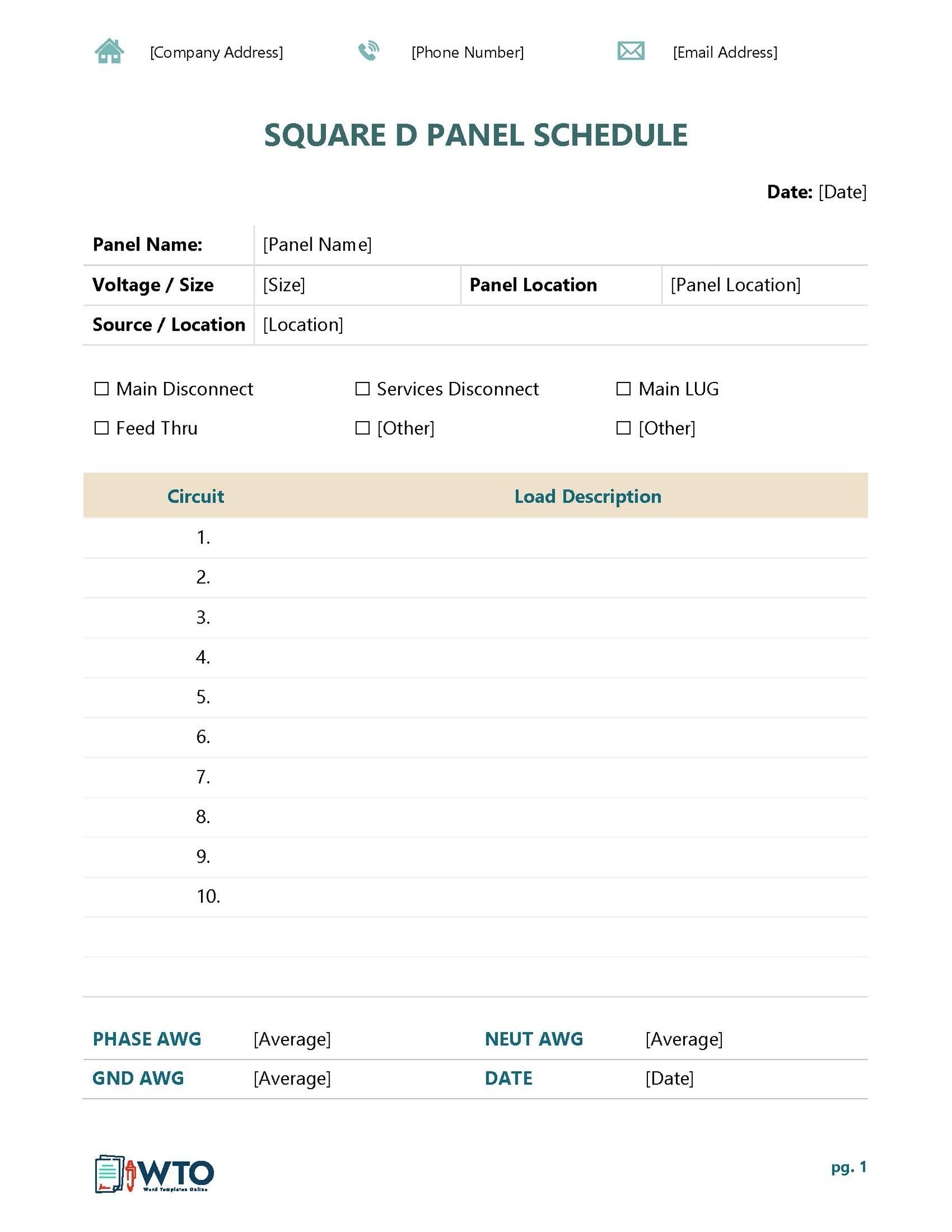
Filling Out a Square D Panel Schedule Template: Step-by-Step Guide
Filling out a template for a Square D panel schedule is a relatively straightforward process. Follow the outline below to complete the template effectively:
Step 1: Understand the template layout
After downloading the template, take time to familiarize yourself with it. Take note of the sections and columns for circuit numbers, descriptions, load calculations, breaker, and wire sizes. Ensure you understand the layout of the template to help you navigate it and input the required information accurately.
Step 2: Gather circuit information
Next, gather all pertinent information about each circuit you need to record to streamline the process of filling out the template. This information includes the purpose and location of each circuit and its load. Ensure you also have accurate details on wire and breaker sizes.
Step 3: Start filling in the template
Start by entering the necessary panel information at the top of the template. These include the panel location, identification number, and network ID. Next, enter the circuit number in the designated column. Follow this with a clear and concise description of the circuit by outlining its purpose and location. In the quadrant column, indicate the zone in which the circuit is located to identify it easily.
Furthermore, enter the load calculation of the circuit in amperes (A) based on its electrical requirements. After entering the load calculation, record the breaker size for each circuit to ensure electrical compliance. Finally, record the wire size to ensure proper wire sizing and selection based on the circuit’s load requirements.
Step 4: Customize columns and sections (if needed)
Depending on your requirements, determine if you need columns for additional information, such as instructions, notes, or circuit ratings. Modify the column widths and row heights to ensure readability if the columns contain additional information. You may also change the fonts, colors, and headers to align with your needs. Customization allows you to capture all the required details in the template.
Step 5: Review and verify the information
Finally, review the template to ensure accuracy and completeness. Double-check circuit numbers, descriptions, breaker sizes, wire information, and load details for potential errors or omissions. The information provided should align with electrical codes and industry standards. Make any necessary updates to ensure the schedule accurately reflects the circuit information.
Common Mistakes to Avoid When Using Square D Panel Schedule Templates
By avoiding errors when using the template, you can ensure the accuracy of your Square D panel schedules.
Discussed below are some common mistakes that may hinder the efficiency of the template:
Lack of flexibility and customization
Templates that lack flexibility can severely limit your customization options. This can lead to omissions when recording unique circuit information or adding columns for specific information. Pick a flexible template that you can modify to accommodate your unique requirements.
Poor organization and clarity
It can be challenging to navigate through and understand the information presented in a template with unclear formatting, labels, and headings. Information presented in a poorly organized manner may lead to confusion, making it harder to locate specific circuits and interpret critical details. Use a well-formatted template with clear headings, rows, and columns for easy readability.
Lack of regular updates
Neglecting to update the template can result in discrepancies in information between the schedule and the actual panel configuration. Outdated information can lead to confusion during future maintenance or troubleshooting procedures. Regularly review and update the template to reflect any modifications made to the electrical panel.
Key Takeaways
- A template for a Square D panel schedule is a valuable tool for electricians, electrical contractors, engineers, and building inspectors alike.
- It provides a structured layout to document information with fields to input circuit numbers, circuit descriptions, breaker sizes, wire sizes, and the load connected to each circuit.
- Using a template promotes safety by ensuring that electrical systems are properly labeled and documented, thus preventing overloads or short circuits in the event of an electricity surge.
- A panel schedule template also allows you to record circuit information in a format that is consistent and compliant with electrical regulations.
- Simply download a template in Word, Excel, or PDF format that best suits your preferences and fill it out with the necessary details.




